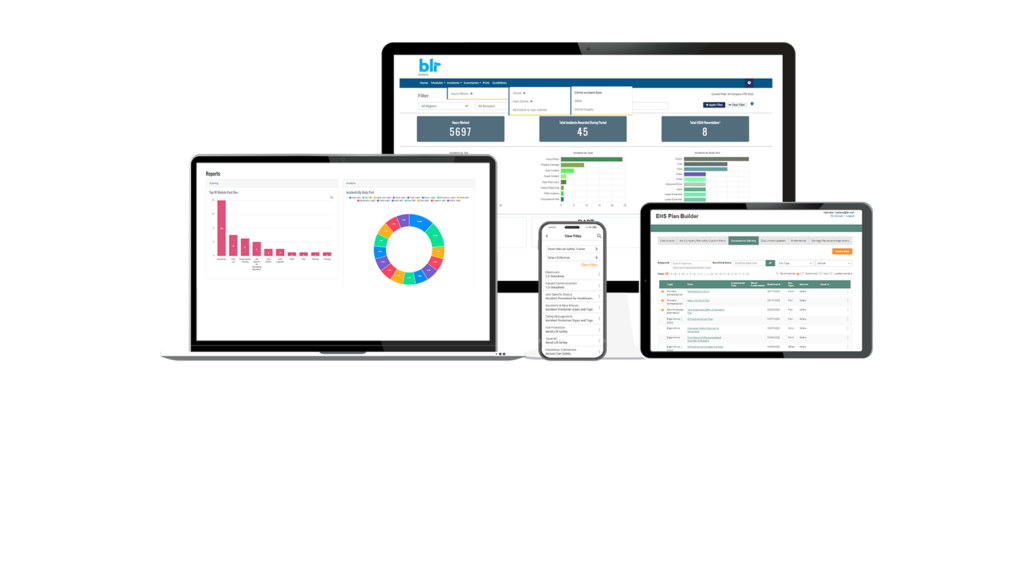
TrainingToday product update: Launch of new safety culture library
At BLR®, we’re constantly bringing you fresh, relevant content. Last month, our learning and development (L&D) and content team launched an all-new Safety Culture course library. Plus, we’ve refreshed several existing food safety courses to keep them current and effective. Keep reading to discover our new and updated courses. Also, we’re sharing handy how-tos for scheduling automated reports in our learning management system (LMS).
New content releases
Safety Culture library
Organizations with strong safety cultures experience reduced safety incidents, lower workers’ compensation costs, increased productivity and employee engagement, and improved corporate reputation.
A dependable safety culture requires buy-in from all levels of an organization. TrainingToday’s safety culture library helps raise the value of safety in your organization and develop the skills needed to create and maintain a safety culture. Some courses are applicable to all employees, and some are specifically designed for supervisors and senior leaders.
- Safety as a Right and a Responsibility: This session explores how a personal commitment to safety is a key enabling factor for a culture of safety.
- What Is Safety Culture: This module will introduce the basics of safety culture: what it is, how it impacts safety performance, and how to identify a strong one.
- Contributing to a Culture of Safety: This session will provide ways to contribute to a culture of safety within an organization.
- Safety Leadership: This session is designed for supervisors; managers; and environment, health, and safety (EHS) professionals to learn more about how to foster a culture of safety through motivating, engaging, and building trust with employees.
- Motivating Employees: Tips and Tactics for Supervisors: This course focuses on motivating employees to perform at their best through a combination of techniques and best practices.
- Effective Safety Communication: This session is designed for supervisors, managers, and EHS professionals to learn how to communicate about safety to enable a strong culture of safety within their organization.
- Creating a Psychologically Safe Workplace: This module is designed for people leaders and provides the knowledge and skills necessary to create higher levels of psychological safety in their teams.
- Organizational Justice and Safety Culture: This course is designed for upper management and executives and covers organizational culture and climate, as well as the concepts of moral disengagement and organizational justice, from a safety perspective.
Want a sneak peek of this new library? Watch a course preview of What is Safety Culture.
Refreshed food safety courses
The consequences of poor food safety practices are detrimental to companies and their customers. If hands are not properly cleaned or food is not stored correctly, people can become very ill. Proper training is needed to ensure that germs, viruses, pesticides, or cleaners don’t contaminate food or drinks.
Several food safety courses have been refreshed and relaunched with a new look and feel.
- Food Service Inspections: This session explains best practices to prepare for a food service inspection of your establishment.
- Food Service Safety: This course covers the key steps to food service safety, from good hygiene to proper food handling and ensuring food service materials and equipment are clean and safe to use.
- Food Service Sanitation: This course provides an understanding of why cleanliness and sanitation are essential in food service, and how to maintain good personal hygiene, identify the characteristics of a clean and sanitary food service establishment, know what to sanitize and how to do it, and prevent pest infestations.
- Food Service Storage: This session focuses on how to store food properly to preserve quality and prevent contamination that can lead to food poisoning.
- Safe Temperatures for Food Storage, Preparation, and Service: This course explains all the important temperatures for storing, preparing, and serving food safely.
The new content is available in the following libraries:
EHS All-Access
- Safety as a Right and a Responsibility
- What Is Safety Culture
- Contributing to a Culture of Safety
- Safety Leadership
- Effective Safety Communication
- Motivating Employees: Tips and Tactics for Supervisors
- Creating a Psychologically Safe Workplace
- Organizational Justice and Safety Culture
Hospitality
- Food Service Inspections
- Food Service Safety
- Food Service Sanitation
- Food Service Storage
- Safe Temperatures for Food Storage, Preparation, and Service
Become a subscriber
Discover our versatile Safety Culture library, available as a stand-alone collection or as part of our comprehensive EHS All-Access library. The EHS All-Access library offers over 300 courses covering workplace safety, transportation safety, environmental compliance, and accident investigation. For those in hospitality, our library offers recently updated food safety courses, as well as guest management, workplace security, emergency action and fire prevention, and personal hygiene and grooming. Choose the perfect fit for your needs, and elevate your safety expertise!
Empower your team with engaging, comprehensive online training for improved performance, compliance, and growth with TrainingToday®. Ready to elevate your team’s success? Don’t wait—contact us today, and unlock the full potential of our cutting-edge online training platform that will transform your workforce!
LMS feature and functionality spotlight
Scheduled Reporting
One of the most popular administrative features in the LMS is scheduled reporting. Our users love that it helps automate their training programs. Scheduled reports save time and effort by tracking key performance indicators (KPIs) and ensuring the organization hits goals and stays compliant. Admins can build a custom report and tailor its delivery depending on their training objective.
Select your customization options while you complete the final steps of your report:
- Name your report so you and other administrators can easily identify it.
- Choose how often you’d like the report to run automatically.
- Run once now. (This option will not set up a recurring report!)
- Monthly—choose the day of the month and what time works best for you. We often see monthly reports running on the 1st or 15th to check compliance completions regularly.
- Weekly—choose a day of the week and time. This is useful for checking the status of new hire onboarding and course completion statuses due within a month of course assignment.
- Daily—choose the time you’d like the report to run. This is helpful for training programs that require frequent monitoring to identify learning challenges.
- Select who else in your organization should receive the report. This is ideal when your HR, compliance, or executive teams need to be in the loop with your training program without needing to log into the system to run the report; it’s delivered to them via e-mail!
- Share the report with other admin-level users within the system. They can then view or edit the report depending on your chosen permission setting.


